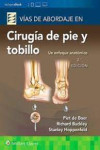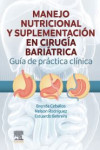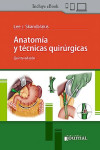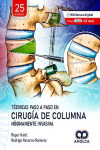ATLAS OF MICROSURGERY OF THE LATERAL SKULL BASE
Sanna, M.
Datos técnicos
- ISBN 9783131010926
- Año Edición 2008
- Páginas 400
- Idioma Inglés
Sinopsis
In this completely revised and enlarged new edition, Professor Sanna and his team provide systematic demonstrations of the major lateral skull base approaches based on 20 years of experience of the Gruppo Otologico, Piacenza, Italy.
The major problem in performing skull base surgery has always been the complex anatomy and the crowding of major neurovascular structures in a deep and relatively inaccessible location. Standard anatomy textbooks fail to address this issue. Therefore, an actual demonstration of the anatomy seen during the different surgical approaches is presented in this book. This is followed by step-by-step descriptions of the surgical technique for each approach and by clinical cases that represent the most commonly encountered lesions so that the surgeon receives a comprehensive understanding of how to perform the approach and what to expect during surgery. "Pearls and pitfalls" at the end of most chapters are practical tips gathered from the vast number of cases managed throughout the years and are included to help others avoid mistakes.
In addition to the description of surgical approaches, introductory chapters on the general principles, instrumentation, and special considerations that characterize this type of surgery are presented. The radiology of skull base lesions is discussed as it relates to surgery, with particular emphasis on findings that can influence the choice of the surgical approach, alter the course of surgery, or affect the prognosis.
Whereas the lateral approaches manage to access the majority of skull base lesions, certain extensive tumors represent particular challenges. For such cases, combined approaches provide the necessary route. These are addressed in detail, as well as management strategies for different skull base lesions (e.g., surgical vs. nonsurgical management, the different factors that determine the choice of the surgical approach, cases that are managed conservatively or with radiosurgery). The management of the internal carotid artery in skull base surgery is discussed in the last chapter, emphasizing the role of the interventional radiologist.
Contents
1 Operating Room Setup
Operating Room Arrangement.
The Patient Position and the Operating Room.
Monitoring.
Preparation of the Operative Site.
Surgeon’s Position.
Microscope.
Instruments Suction Irrigation.
Drills.
Bipolar Coagulation.
Microinstruments.
Postoperative Care
2 Special Considerations in Skull Base Surgery
Introduction.
General Guidelines for Drilling.
Management of Bleeding.
Monopolar Coagulation.
Bipolar Coagulation.
Bleeding from Bony Surfaces.
Gelatin Sponge.
Oxidized Cellulose and Oxidized Regenerated Cellulose.
How to Deal with Brain Tissue and Other.
Neurovascular Structures.
Techniques of Tumor Dissection and Removal.
How to Widen the Access to the Tumor
3 Radiology of the Lateral Skull Base
Introduction.
Intradural Lesions (Cerebellopontine Angle).
Extra-axial Lesions.
Intra-axial Lesions.
Skull Base Tumors Extending into the Cerebellopontine.
Angle.
Extradural Lesions.
Petrous Apex Lesions.
Clival Lesions Jugular Foramen Tumors
4 Introduction to Lateral Skull Base Surgery
Classification of the Lateral Skull Base Approaches.
Surgical Anatomy.
Surgical Anatomy of the Temporal Bone as Related to.
Lateral Skull Base Surgery.
Surgical Anatomy of the Posterior Cranial Fossa
5 The Translabyrinthine Approaches
The Enlarged Translabyrinthine Approach.
Rationale.
Indications.
Contraindications.
Surgical Anatomy.
Surgical Technique.
Clinical Application.
Pearls and Pitfalls.
Advantages.
Disadvantages.
The Enlarged Translabyrinthine Approach with.
Transapical Extension.
Rationale.
Indications.
Limitations.
Surgical Technique.
Clinical Applications.
Pearls and Pitfalls.
Advantages.
Disadvantages.
Brainstem Implantation.
Absolute Indications.
Relative Indications.
Clinical Application
6 The Transcochlear Approaches
Introduction.
The Transotic Approach.
Rationale.
Indications.
Surgical Technique.
Surgical Anatomy after Opening the Dura.
Clinical Application.
Pearls and Pitfalls.
Advantages.
Disadvantages.
The Modified Transcochlear Approaches.
Classification.
Type A Modified Transcochlear Approach.
(The Basic Type).
Indications.
Surgical Technique (Right Side).
Surgical A.
Closure.
Anatomy after Opening the Dura.
Clinical Applications.
Pearls and Pitfalls.
Advantages.
Disadvantages.
Type B Modified Transcochlear Approach.
Indications.
Surgical Steps Clinical Application.
Pearls and Pitfalls.
The Type C Modified Transcochlear Approach.
Indications.
Surgical Steps.
Clinical Application.
The Type D Modified Transcochlear Approach.
Indications.
Surgical Steps.
Clinical Application
7 The Middle Fossa Approaches
Classification.
Indications.
Surgical Anatomy.
Special Positioning.
Surgical Technique.
Surgical Anatomy after Opening of the Dura.
Closure.
Clinical Applications Pearls and Pitfalls
8 Approaches to the Jugular Foramen
Infratemporal Fossa Approach Type A.
Rationale.
Indications.
Surgical Anatomy.
Surgical Technique.
Special Considerations.
Removal of a Left Tumor with Invasion ofe Inner Ear.
Sacrifice of the Internal Carotid Artery.
Removal of Tumors with Invasion of the Left Internal.
Auditory Canal.
Facial Nerve Involvement.
Presence of Ipsilateral Carotid Body Tumor.
Single-stage Removal of Tumor with Small.
Intradural Extension (C3Di1).
Staged Removal of Tumors with Intradural Extension.
Petro-occipital Transsigmoid Approach for Second-stage.
Removal of Intradural Glomus Tumors.
Staged Removal of C3Di2 Glomus Tumor (Right Side).
Pearls and Pitfalls.
The Petro-Occipital Transsigmoid (POTS) Approach.
Rationale.
Indications.
Contraindications.
Surgical Anatomy.
Surgical Technique.
Surgical Anatomy after Opening the Dura.
Clinical Applications.
Pearls and Pitfalls.
Results.
Advantages.
Disadvantages.
Combinations with the POTS Approach.
Clinical Application
9 Approaches to the Infratemporal Fossa
Infratemporal Fossa Approach Type B.
Rationale.
Indications.
Surgical Anatomy.
Surgical Technique (Left Side).
Clinical Applications.
Advantages.
Disadvantages.
Limitations.
Infratemporal Fossa Approach Type C.
Rationale.
Indications.
Surgical Anatomy.
Surgical Technique.
Clinical Applications.
Pearls and Pitfalls.
Advantages.
Disadvantages.
Limitations.
The Group of Preauricular Transzygomatic Approaches.
Type D Infratemporal Fossa Approach.
Preauricular Infratemporal Transzygomatic Approach.
Preauricular Frontotemporal Orbitozygomatic Approach.
Indications for the Preauricular Infratemporal.
Transzygomatic Approaches.
Surgical Anatomy.
Surgical Technique.
Clinical Applications.
Pearls and Pitfalls.
Advantages.
Disadvantages
10 The Retrosigmoid Retrolabyrinthine Approach
Rationale.
Indications.
Surgical Anatomy.
Surgical Technique.
Surgical Anatomy after Opening the Dura.
Clinical Applications.
Pearls and Pitfalls.
Advantages.
Disadvantages
11 The Extreme Lateral Approach (Far Lateral, Transcondylar)
Rationale.
Indications.
Surgical Anatomy.
Surgical Technique.
Surgical Anatomy after Opening the Dura.
Closure.
Clinical Application Pearls and Pitfalls.
Contents
12 Combined Approaches
Introduction.
Retrolabyrinthine Subtemporal Transapical and.
Retrolabyrinthine Transtentorial Approaches.
Rationale.
Indications.
Surgical Anatomy.
Surgical Technique.
Retrolabyrinthine Subtemporal Transapical.
(Transpetrous Apex) Approach.
Retrolabyrinthine Subtemporal Transtentorial.
Approach.
Clinical Applications.
Pearls and Pitfalls.
Combined Transpetrous Orbitozygomatic Approaches.
Rationale.
Indications.
Approaches and Clinical Applications.
Combined Transcochlear Orbitozygomatic Approach.
Combined Retrolabyrinthine Subtemporal.
Orbitozygomatic Approach.
Combined Translabyrinthine Transapical.
Orbitozygomatic Approach.
Combined Infratemporal Transzygomatic Approach.
Pearls and Pitfalls for the Combined Transpetrous.
Orbitozygomatic Approaches.
Advantages of the Combined Transpetrous.
Orbitozygomatic Approaches.
Disadvantages
13 Decision Making in Skull Base Surgery
Introduction.
Surgical Management.
Jugular Foramen Tumors.
Glomus Jugular Tumors (Chemodectomas).
Lower Cranial Nerve Schwannoma.
Jugular Foramen Meningioma.
Cerebellopontine Angle Tumors.
Acoustic Neurinoma.
Meningioma.
Epidermoids Clival and Petroclival Tumors.
Intradural Lesions.
Extradural Lesions.
Petrous Apex Lesions.
Cholesterol Granuloma.
Cholesteatoma.
Chordomas, Chondromas, and Chondrosarcomas.
Nonsurgical Lesions.
Meckel’s Cave Area.
Special Considerations.
Staging.
Total vs. Subtotal Removal.
When Not To Do Surgery
14 General Principles of Embolization in Skull Base Tumors
Introduction.
Embolization of Juvenile Nasopharyngeal.
Angiofibroma.
Embolization of Glomus Tumors of.
the Temporal Bone.
Embolization of Meningiomas of the Skull Base
15 Management of the Internal Carotid Artery
in Skull Base Surgery.
Introduction.
Surgical Anatomy.
Pathologies.
Normal Angiographic Anatomy of the Internal.
Carotid Artery and of the Circle of Willis.
The Internal Carotid Artery.
The Circle of Willis.
Preoperative Neuroradiological Assessment of the.
Internal Carotid Artery.
Interventional Neuroradiological Management of the.
Internal Carotid Artery.
Permanent Balloon Occlusion of the Internal.
Carotid Artery.
Preoperative Stenting of the Internal Carotid Artery.
Surgical Management Modalities of the Internal.
Carotid Artery.
Skeletonization.
Displacement.
Subperiosteal/Subadventitial Dissection.
Dissection and Resection after Permanent Balloon.
Occlusion of the Internal Carotid Artery.
Subadventitial Dissection after Reinforcement with.
Stenting.
Clinical Application of Carotid Artery Stenting
Literature
Otros libros que te pueden interesar
- ¿Quiénes somos?
- Gastos de envío
- Política de privacidad
- Políticas de devolución y anulación
- Condiciones Generales de contratación
- Contacto
2024 © Vuestros Libros Siglo XXI | Desarrollo Web Factor Ideas










